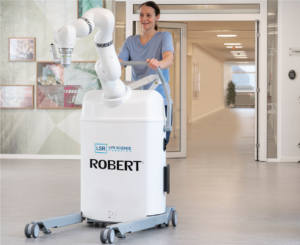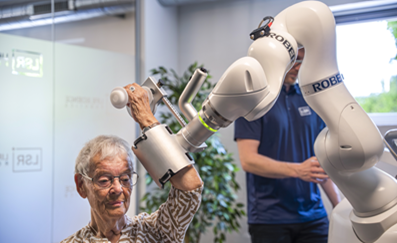Meeting the 2023 National Clinical Guideline for Stroke with the ROBERT®
Life Science Robotics
In this new blog series we’re taking a look at the National Clinical Guideline for Stroke, which defines recommended best practices within stroke care in the UK. This guideline provides much-needed updates to recommendations on rehabilitation, psychological and emotional support, and return to work services, amongst many other changes.
In light of these recommendations, we’re reviewing all our clinical solutions and sharing the ways in which these meet the 2023 guidelines. This is to help clinicians assess the rehabilitation technology we offer and how these devices can support patients recovering from a stroke, as well as support the stroke services offering this rehabilitation.
In this week’s blog we’re looking at the ROBERT®, a robotic therapy device that delivers early rehabilitation to both the upper and lower limb.
About the ROBERT®
The ROBERT® is an innovative robotic rehabilitation device that focuses on delivering efficient therapy for clinicians and providing active and early mobilisation for acute patients. The unique 7 degrees of freedom allows therapists to perform and record an initial movement, and then the device repeats this to deliver the desired frequency and intensity. This can include Activities of Daily Living and Proprioceptive Neuromuscular Facilitation.
The ROBERT® uniquely trains both the upper and lower limb with the same device, and can be used either in-bed or seated. Optional Functional Electrical Stimulation (FES)
ROBERT® is developed by Life Science Robotics and distributed in the UK by Summit Medical and Scientific. Read more about the ROBERT® here.
Meeting the 2023 Stroke Guidelines
So how does the ROBERT® robotic rehabilitation device meet the National Clinical Guideline For Stroke?
1. The ROBERT® helps to mobilise patients between 24 and 48 hours of stroke onset.
2. The ROBERT® helps to provide 3 hours of multidisciplinary team therapy a day.
3. The ROBERT® supports delivering a range of individualised one-to-one therapies, structured semi-supervised practice, and group work.
4. The ROBERT® helps provide therapy within the first two weeks as frequent, short interventions every day.
5. The ROBERT® supports how people with weakness should be taught task-specific, repetitive, intensive exercises or activities to increase their strength.
6. The ROBERT® helps clinicians offer people with some upper limb movement repetitive task practice with a high number of repetitions.
7. People with reduced arm function after a stroke may be considered for robot-assisted movement therapy.
Get in touch with Summit Medical and Scientific today to discuss integrating the ROBERT® into your clinical stroke practice.
About Summit Medical and Scientific

Summit Medical and Scientific are passionate about the power of rehabilitation technology.
We represent clinical technology leaders Hocoma, Motek and Life Science Robotics to provide the total solution for rehabilitation in the UK. Our partners have developed innovative therapy devices using robotics, sensors and virtual reality for early and acute rehabilitation, gait and balance therapy, arm and hand therapy, body weight support and more. View all of our clinical solutions here.
Get in touch with Summit Medical and Scientific today to find out more about incorporating state-of-the-art rehabilitation technology into your practice.
You can also follow us on Facebook, Twitter and LinkedIn, and subscribe to our newsletter for the latest updates.

